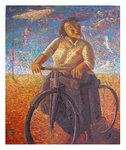
How do artists interpret the Dalai Lama? In 2004, when Randy Jayne Rosenberg was invited to curate the exhibition, she knew little about Buddhism and Tibet but understood the overarching vision: to portray His Holiness on a broad, universal platform.
Eighty artists from around the world tapped into their unique journeys and belief systems to create works showing how they perceive the Dalai Lama. The result is a tapestry of images, themes, and media that suggest the many roles the Dalai Lama plays within his world and ours: statesman, philosopher, politician, holy man, visionary, peacemaker, icon, and more.
The artists’ interpretations resonate with the great themes and ideals that the Dalai Lama embodies: the power of spirituality, the mystery of transcendence, universal interconnectedness, the need for peace. The exhibition begins with concrete concepts: the Dalai Lama’s appearance, religion, and homeland. It then circles outward into increasingly abstract and all-encompassing themes: human rights; compassion; the plight of people in exile; paths of transformation; universal responsibility; globalization; temporality; and impermanence.
 This photograph by Richard Avedon was printed in 2003.
This photograph by Richard Avedon was printed in 2003.
This video-based installation by Hi-Jin and David Hodge explores the temporal nature of life, featuring segments of interviews with more than 120 people. The installation is intended to promote reflection about who we are as human beings and how we are living in the world.

This painting by Guy Buffet imagines the Dalai Lama's response to petty annoyances.
 With this intricate oil painting, Dario Camapanile imagines the day when peace is achieved. La Pace e con Noi (Peace is with Us),
With this intricate oil painting, Dario Camapanile imagines the day when peace is achieved. La Pace e con Noi (Peace is with Us),  Artist Binh Dahn prints photographic images onto leaves, then casts the leaves in resin. His work addresses compassion, unconditional love, and the importance of forgiveness.
Artist Binh Dahn prints photographic images onto leaves, then casts the leaves in resin. His work addresses compassion, unconditional love, and the importance of forgiveness.
 Brief History of Tibet, by Tenzing Rigdol
Brief History of Tibet, by Tenzing Rigdol
 Seyed Alavi's works convert contemporary signage into drawings that prompt reflection on the nature of our lives as human beings.
Seyed Alavi's works convert contemporary signage into drawings that prompt reflection on the nature of our lives as human beings.  I Saw the Figure Five in Gold, by Ken Aptekar
I Saw the Figure Five in Gold, by Ken Aptekar





No comments:
Post a Comment